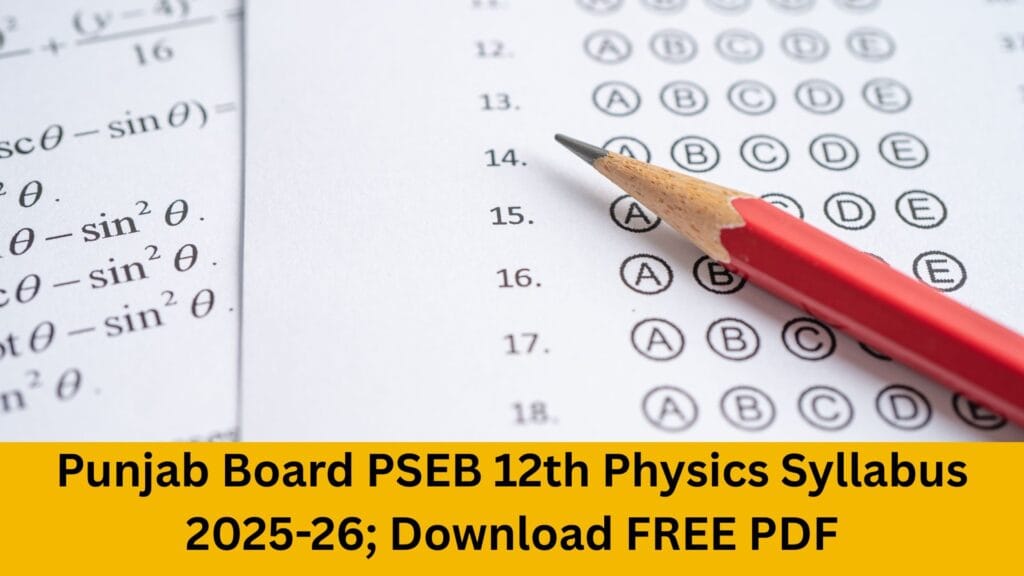
The Punjab School Education Board (PSEB) has officially released the updated syllabus for Class 12 Physics for the academic year 2025-2026. This crucial document is now accessible on the official PSEB website, serving as an indispensable tool for all students aiming to excel in the upcoming 2026 PSEB Class 12 Board Examination.
Success in board examinations, particularly in a challenging and intricate subject such as Physics, demands a profound understanding and consistent revision of the prescribed syllabus. his holds true not just for Physics, but for all subjects. This article aims to provide a detailed walkthrough of the revised Physics curriculum, offering clarity and guidance to students. To further support their learning journey, a complimentary PDF version of the complete syllabus is available, ensuring easy and convenient access to this vital resource. This initiative is designed to streamline the preparation process, empowering students to approach the subject with heightened confidence and a clear grasp of its core principles. By continously studying the revised syllabus, students can strategically plan their studies, prioritize topics, and allocate sufficient time to complex areas, ultimately enhancing their performance in the board examinations.
PSEB Class 12th Physics Syllabus 2025-26
The detailed syllabus for the Punjab board Physics has been updated in the table given below. Candidates can refer the table below.
Unit-1: Electrostatics |
|
Unit-II: Current Electricity |
|
Unit-III: Magnetic Effects of Current and Magnetism |
|
Unit-IV: Electromagnetic Induction and Alternating Currents
|
Unit-V: Electromagnetic Waves
|
Unit-VI:Optics
|
Unit-VII: Dual nature of Matter and Radiation
|
Unit-VIII: Atoms &Nuclei
|
Unit-IX: Electronic Devices
|
Practical Syllabus |
SECTION-A |
1. To determine resistance per unit length of a given wire by plotting a graph of potential difference versus current. 2. To find resistance of a given wire using meter bridge and hence determine the specific resistance of its material. 3. To determine resistance of a galvanometer by half-deflection method and to find its figure of merit. 4. To convert the given galvanometer of known resistance and figure of merit into an ammeter and voltmeter of desired range and to verify the same. |
SECTION-B |
1. To find the value of v for different values of u in case of a concave mirror and find their focal length. 2. To find the focal length of a convex lens by plotting graphs between u and v or between 1/u and I/v. 3. To find the local length of a convex mirror, using a convex lens. 4. To find the focal length of a concave lens, using a convex lens. 5. To determine angle of minimum deviation for a given prism by plotting a graph between angle of incidence and angle of deviation. 6. To draw the I-V characteristic curve of a p-n junction in forward bias and reverse bias. 7. To determine the reflective index of a glass slab using a traveling microscope. 8. To find refractive index of a liquid by using (i) Concave mirror. (ii) Convex lens and plane mirror. |
PSEB Class 12th Physics Marks Distribution and Course Structure
Course Structure | Marks Distribution |
Theory | 70 |
Practical | 30 |
Total | 100 |
Structure of Paper – Practical
Detail | Marks |
Two experiment | 10 |
Record of Activities | 02 |
Viva on Activities | 03 |
Record of Experiments | 02 |
Viva of Experiments | 03 |
Investigatory Project | 05 |
Total | 25 |
PSEB Class 12th Physics Syllabus Download
Students who are looking for the Punjab Board class 12th syllabus for the academic year 2025 can download the updated syllabus from the link given below.
PSEB Class 12th Physics Syllabus PDF – Download
